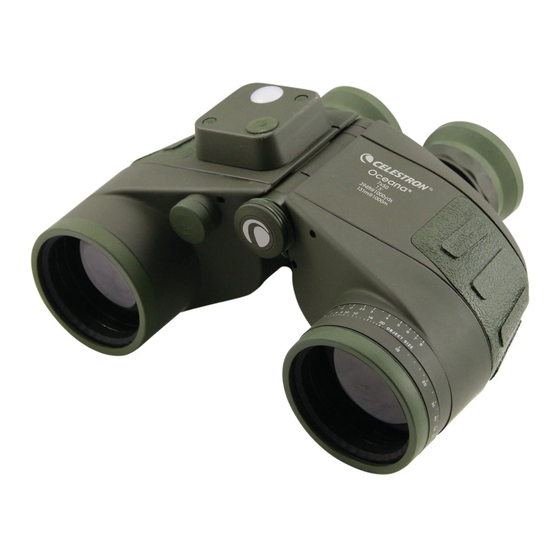
Advertisement
Quick Links
A
i
djusting the
nterpupillAry
Since the distance between the eyes (specifically, the distance between the
centers of the pupils) varies among individuals, the two eyepieces of the
binoculars must be correctly aligned (adjusted). This is called adjusting the
interpupillary distance. To adjust this distance, lift the binoculars up to your eyes
(using both hands) and look through them at an object in the distance. Move
the two halves of the binoculars about the hinge until you see one clear circle of
image through both eyes.
A
F
djusting
ocus
This binocular has an individual focus system which requires that you focus each
eyepiece for the clearest and sharpest views. Start by selecting an object to look
at – (1) Close your right eye and rotate the left diopter until the object appears
sharp and clear; (2) Open your right eye and close your left eye and rotate the
right diopter until the object appears sharp and clear; (3) With both eyes open
the object should be sharp and clear; (4) Focusing on other objects requires that
you follow the steps above; (5) To return to the original object, note the diopter
adjustment scale settings so you can quickly obtain the best focus position.
Hint: Eyeglasses worn for nearsightedness should be worn when using binoculars
as you may not be able to reach a sharp focus at infinity without them.
s
r
e
et the
ubber
yecups
Keep the Rubber Eyecups up if you do not wear eyeglasses but fold them down
if you do wear eyeglasses to obtain the maximum field of view.
p
b
Arts oF the
inoculAr
1. Eyepieces
2. Main Body
3. Objective Lenses
4. Body Shaft
5. IPD Scale
6. Tripod Adapter Threads
7. Rubber Eyecups
7
13
8
9
10
3
11
o
ceAnA
d
(ipd)
istAnce
IPD Scale
8. Compass Window
9. Button for Compass
Illuminator
10. Battery Compartment
11. Objective Lens Caps
12. Eyepiece Protective Cap
13. Diopter Adjustment Ring
1
7
13
5
4
6
12
7
50 b
M
x
inoculAr
i
b
nstAlling the
(
) b
or equivAlent
The batteries included with your binocular are for illuminating the compass,
so you can see it easily in the dark. You need to install the batteries which are
located in the case pocket. Unscrew the battery cap by hand and then remove
the screw with a coin or screwdriver. The batteries are to be installed with the
positive (+) side facing up towards you. Replace the screw and battery cap. If
you will not be using the binocular for a long period of time (a few months or
more), you should take the batteries out to preserve their life.
u
r
sing the
eticle As A
V
A
iew
ngle
View Angle of an object is the angle between the rays
from the binocular to its edges. Usually, this angle is
measured at the horizontal or vertical direction, and
defined as Horizontal View Angle and Vertical
View Angle.
A mil's reticle (shown to the right) that has a horizontal
and vertical scale can measure the viewing angle of
an object. The Celestron binocular uses 10 mils for each
number (1,2,3,... as shown here).
M
h
eAsuring the
orizontAl
When the Horizontal View Angle is smaller than the horizontal
scale range (-40~+40 mils) inside the binocular, aim one
edge of the object at a horizontal scale line (the center or
the outmost line is selected according to the image size
of the object usually) and read its value. Then read the
value of the scale at which another edge was located.
Add these two values and this is the measured Horizontal
View Angle. The Horizontal View Angle of the target
(sailboat) is 2 decade mils (20 mils), and the Horizontal View
Angle between the targets is 4 decade mils (40 mils).
When the Horizontal View Angle is larger than the horizontal scale range
(-40~+40 mils), use vertical line splits (for example: mast, sail, etc.) on the object
can be selected to make the necessary estimated measurements in a step by
step fashion.
2
M
V
eAsuring the
erticAl
Vertical View Angle measurement is similar to measuring
the Horizontal View Angle. When the Vertical View
Angle measurement is small, aim the intersecting point
of the vertical and horizontal lines of the reticle at
the lower part of the object and read the scale value
at the top of the object. The angle included between
the upper and lower parts of the target (lighthouse) is 6
decade mils (60 mils).
When the Vertical View Angle is larger than the vertical scale range (80 mils), it
can be measured in steps, and the angle can be obtained by summing up the
value of each step.
u
r
sing the
eticle to
The distance measurement of a target can be calculated by using the mil reticle.
11
The formula of distance measurement: L(km) = H (m)/ω
L
— the distance between the observer and the object (km)
H —
the height of the object (m)
ω —
the View Angle of the object measured with the reticle
of the binocular (mil).
# 71189-b
odel
– t
lr1142
Atteries
wo
c
utton
ell
M
d
eAsuring
evice
V
A
iew
ngle
V
A
iew
ngle
M
D
eAsure
istAnce
ENGLISH
Advertisement

Summary of Contents for Celestron Oceana 71189-B
- Page 1 The Celestron binocular uses 10 mils for each Keep the Rubber Eyecups up if you do not wear eyeglasses but fold them down number (1,2,3,… as shown here). if you do wear eyeglasses to obtain the maximum field of view.
- Page 2 Alternately, you could use the Celestron LensPen (# 93575) made especially for cleaning binoculars. Never attempt to clean your binocular internally or try to...















Need help?
Do you have a question about the Oceana 71189-B and is the answer not in the manual?
Questions and answers